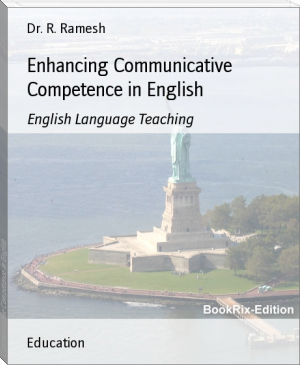Multicultural Skills (manual coursebook), Asier Barandiaran, Dmitrii Enygin, Venera Midova [fiction novels to read TXT] 📗

- Author: Asier Barandiaran, Dmitrii Enygin, Venera Midova
Book online «Multicultural Skills (manual coursebook), Asier Barandiaran, Dmitrii Enygin, Venera Midova [fiction novels to read TXT] 📗». Author Asier Barandiaran, Dmitrii Enygin, Venera Midova
5. believes that in everyday communication, nationality does not matter
6. prefers the lifestyle of only my people
7. usually does not hide his/her nationality
8. considers that true friendship can only be between people of one nationality
9. often feels ashamed of people of native nationality
10. considers that any means are good for protecting the interests of its people
11. does not give preference to any national culture, including its own
12. often feels the superiority of his people over others
13. he loves his people, but respects the language and culture of other peoples
14. considers it strictly necessary to preserve the purity of the nation
15. difficult to get along with people of native nationality
16. considers that interaction with people of other nationalities is often a source of trouble
17. indifferent to their nationality
18. is stressed when he hears someone's speech around him
19. ready to deal with a representative of any people, despite national differences
20. considers that his people have the right to solve their problems at the expense of other peoples
21. often feels inferior because of his nationality
22. considers his people more gifted and developed than other nations
23. considers that people of other nationalities should be restricted in their right to reside on its national territory
24. is irritated by close communication with people of other nationalities
25. always finds an opportunity to peacefully negotiate in an interethnic dispute
26. considers it necessary to "purify" the culture of native people from the influence of other cultures
27. does not respect his/her people
28. considers that on his land all rights to use natural and social resources should belong only to his people
29. never took seriously the interethnic problems
30. believes that his people are no better and no worse than other peoples
Processing Results
The answers are translated into points according to the scale:
Agree - 4 points
Basically Agree - 3 points
Agree partly - 2 points
Disagree - 1 point
Strongly Disagree - 0 points
Then the number of points for each type of ethnic identity is calculated (in parentheses points are indicated that work for this type):
1. Ethnonigilism (items: 3, 9, 15, 21, 27).
2. Ethnic indifference (5, 11, 17, 29, 30).
3. Norma (positive ethnic identity) (1, 7, 13, 19, 25).
4. Ethno-egoism (6, 12, 16, 18, 24).
5. Ethno-isolationism (2, 8, 20, 22, 26).
6. Ethnophanatism (4, 10, 14, 23, 28).
Depending on the sum of scores collected by the subject on a given scale (the possible range is from 0 to 20 points), one can judge the severity of the corresponding type of ethnic identity, and comparing the results across all scales allows one or several dominant types to be distinguished.
PART 5. CONFLICT RESOLUTION
Conflict management, like effective communication skills, is another important element of social competency. This chapter promotes the use of several forms of conflict management such as negotiation and self-control. The main aim here is to educate the students about ways to communicate effectively when trying to resolve a conflict and/or reach a compromise.
Activity 1: Review of Communication Observations
The instructor should take 5 minutes to ask students to share their experiences of observing how people communicate in daily interactions.
Activity 2: Blind Drawing Activity
Task Objectives: Listening and communicating, reading verbal and nonverbal cues, cooperation
Materials: 2-4 simple, pre-drawn pictures for each group; paper and pencils
Instructions: “Listening and communicating can sometimes be frustrating. Each and every day, it seems as though someone is giving us directions or information that we need to pay attention to, using verbal and nonverbal cues.”
After handing each student 3 pieces of paper, one student will be the “explainer” and will hold a picture in his or her hand and will give directions to the other students, the “drawers”, about how to draw the picture as accurately as possible. None of those who are drawing the picture gets to see it, only the person who is explaining it gets to look at the picture. The “drawers” also have to turn their backs to the explainer, while drawing the picture. That is, the explainer only gets to use his or her voice (with no body language or facial expressions) to explain what the picture looks like. You may not ask the explainer any questions.
After students compare their drawings with the picture, ask students to say how easy or hard the task was for them and what made it easy or hard. Next, tell them they are going to draw two more pictures that two more of the students will describe and then you will discuss the activity in more detail.
Pick a student to be the “explainer” and give him or her the first picture, set a time limit (e.g.,“you have 5 minutes”) and tell the “explainer” to begin describing the picture to the “drawers.”
When time is up, have the explainer show the group the picture and have members compare how they did. Ask students to say how easy or hard the task was for them (get a hand showing for: very easy, some what easy, somewhat hard, very hard).
Select a different person to be the “explainer.”
PROCESS QUESTIONS:
What was the most frustrating part of doing this activity?
What helped you as the “explainer” to do the best job describing the picture?
What helped you as the “drawer” to understand what you needed to draw?
What did you do when you were having difficulty explaining the picture?
What did you do when you had difficulty understanding what to draw?
In real life when you do not understand what someone is telling you, how do you react to that situation? What are the things you do to understand them better?
Why is it important to take the time to understand what someone is trying to tell you?
What do you do when you are trying to tell someone something and they do not seem to understand you?
Why is it important to take the time to explain something important to someone when at first they do not understand what you mean?
Point out that feeling frustrated is natural. Finding ways to understand what a person means or to be understood if you are the person talking can help to reduce frustration and conflict that can result when people are not understanding each other.
Encourage the group to discuss the differences in communication that were used, the effectiveness of one type of communication over another, and conclusions about what good communication really is.
Negotiation Game
Task Objectives: learning how to discuss and negotiate as a means of reaching a compromise; learning how to see and respect another person/groups’ point of view. The ultimate goal is learning to work together to negotiate a solution (i.e., reach a compromise) that both parents and teens think is acceptable and fair.
Instructions:
Materials: flip chart and markers; make signs that say things like: “good job” “too aggressive” “slow down” “take turns” for jury to hold up during the negotiation
Step 1: Have the students form two groups (the parent group and the teen group – pick an age for the teen group that is 1-2 years younger than the students, e.g., 14 years old). Select a topic: teen drinking alcohol, teen smoking, curfew, teens’ style of dress, teen’s amount of (unsupervised) time with friends, teens’ educational activities (both during school and at home), teen responsibilities (e.g. chores, conduct, effort in school) and teen freedoms (unsupervised time with friends, dating, weekend activities with friends, ... (it can include other topics suggested by the group).
Explain that the group will be engaging in collaborative problem solving as the play the negotiation game. Collaborative problem solving involves six important steps:
· Step 1: Establish ground rules
· Step 2: Reach mutual understanding
· Step 3: Brainstorm
· Step 4: Agree to one or more solutions
· Step 5: Write down your agreement
· Step 6: Set a time for a follow-up discussion to evaluate your progress
Explain to all the participants that ground rules must be established first, such as: no yelling, listen without interrupting... Have the students make a list of 3-4 ground rules to ensure everyone will be able to work together. Post the ground rules on the wall for all to see (step 1: ground rules).
Next, have all participants agree that they are there to work out the problem they have selected (step 2: mutual understanding about the problem to be solved).
Third, have the teen and parent groups move to different parts of the room and have each group brainstorm (step 3) all possible solutions to the problem (remind the group playing parents, that they need to take their parents’ perspectives; remind the teen group to remember back to when they were “fourteen” or “fifteen” and how they felt about the issue).
Have each group select 2 participants to play the “jury.” The jury will watch the parent and teen group discuss ways to solve the problem and will evaluate how well the process goes. Give the jury signs that say: “slow down” “speak louder” “take turns” “be calm” “good job” (add other signs as needed). The jury will hold up these signs as the negotiation process is occurring. The parent and teen group members should be asked to heed the jury’s signs.
Bring the groups together and move to Step 4 “the negotiation process”: Have the group review the list of possible solutions that the teen and parent groups generated. Have them discuss the pros and cons of the solutions. Mark out solutions that both groups say will not work. Have the group keep working until they arrive at one or more solutions to the problem that both think will work. To finish the negotiation, write down the agreed upon solution and agree on a time frame for testing out the solution (steps 5 & 6).
After the negotiation process is over, ask the jury to rate (on a scale of 1(did not do well) to 5 (did very well) how well the participants did on the following:
-taking the discussion seriously
-listening to each others’ views
-trying to compromise
-accomplishing the overall goal of the activity
Discuss with the group how they could have improved their negotiation process.
Have participants from the two groups shake hands to end the game. If there is time – pick a second topic, have the two sides switch roles (teen group plays parent group; parent group plays teen group) and repeat the game.
Apply the experience to real life:
What kinds of responses help to end a conflict between parents and teens?
What kinds of response make a conflict get worse?
What helps parents and teens come to an understanding of one another’s points of view?
What are some things you have done in the past to work out a disagreement with your parents?
How does the negotiation process apply to conflicts with people of your own age?
What have some of you done to work out a disagreement or conflict with another person of your age?
Creative Experience:
Observe on television shows you watch this week any conflicts between 2 or more people about your age; think about how you would have handled the conflict.
Optional task:
In small groups or with a partner, consider the following statements:
Conflict is a contest
Conflict is negative.
Are either one of these two statements generally true or generally false?
If one or both are generally true, explain your reasoning and give one or two examples.
If one or both are generally false, explain that reasoning also, with one or two examples.
Optional task:
Identify a workplace conflict that you might be personally involved with and not pleased with the outcome. The situation you use for this exercise should be a one-on-one example not you vs. a group or organization. The situation should be from an actual experience, not a hypothetical story. Individually respond to the following questions:
What did you do to contribute to the conflict?
From your point of view, what is the worst part of what happened?
If you could do it over, what, if anything would you do differently?
Now, in your group or with a partner, explain your situation by telling them the story of this conflict, but only tell them what happened, not who or where it happened. Just tell them the story, rather than share the answers to the questions.
Optional task:
When conflict remains unresolved in the workplace, it can negatively affect employee performance and productivity. Employees may exhibit some of the following symptoms:
Self–





Comments (0)